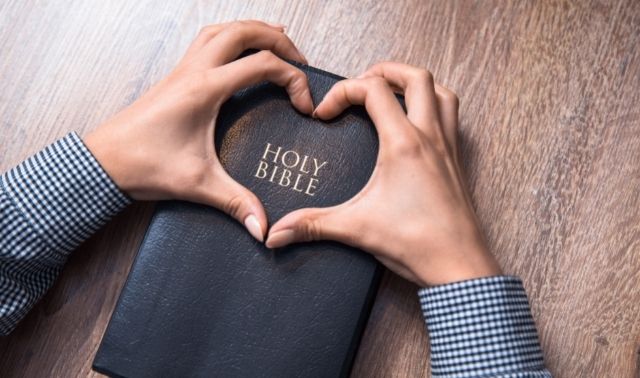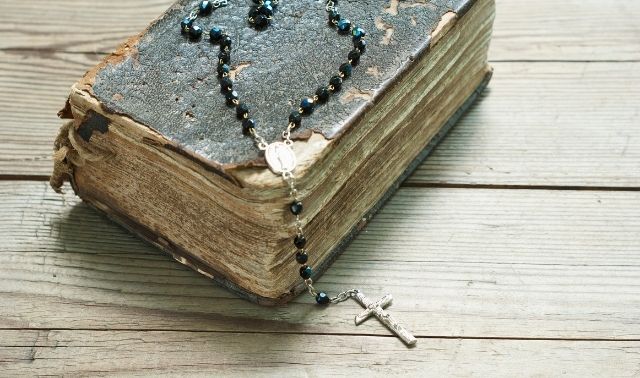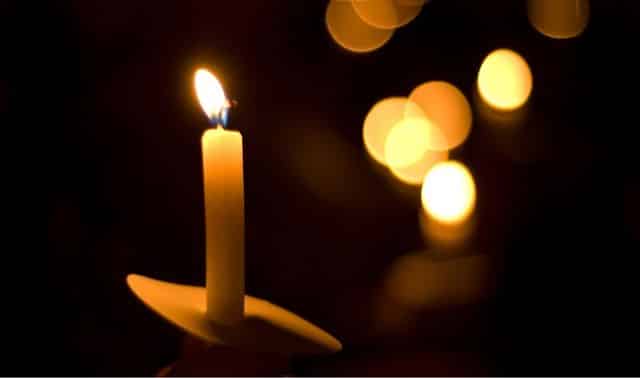Sign up for the Family Tree Newsletter Plus, you’ll receive our 10 Essential Genealogy Research Forms PDF as a special thank you!
Get Your Free Genealogy Forms
"*" indicates required fields
In this article:
Tips for Handling Family Bibles
Analyzing Entries: A Case Study
What’s the number-one best-selling, most widely read book of all time? No, it’s not one by Stephen King, John Grisham or Danielle Steele. It’s the Bible. Since at least 1611 — the first popular English-edition printing of the King James Version — the Bible has been purchased and read by millions of people. For many of your ancestors, this was the only book they possessed. Family members learned how to read from it; some learned how to write, copying down passages for practice. Before radio and TV, for entertainment in the evenings the head of the household or someone needing to practice reading skills would read Bible stories out loud to the rest of the family. No wonder this central book in peoples’ lives would be the same volume in which they would record their family’s life events: births, marriages and deaths.
Your early American ancestors either brought their family Bibles with them from their homeland or purchased them from importers. The first Bible printed in the United States was in 1782, and not long after, in 1791, the first “Family Bible” was printed and sold. In the days before Amazon.com, Bible salesmen went door to door selling family Bibles, making them popular among middle-class Americans.
Inserted within these Bibles were family pages to record births, marriages and deaths. Some pages were ornately illustrated; others were just blank pages. In the entries, you’ll typically find a person’s full name and the date when the event took place. Meticulous record keepers might also include the place of a birth, marriage or death. Or you may find a genealogical Holy Grail in a family Bible, such as in the Matteson Family Bible (published in 1832):
This Bible Grandfather Elisha Matteson and his wife Chole Austin, Matteson of Dorcel, Bennington Co, Vermont “owned” Moved to East Hounsfield, N. Tin 1807 — Married May 15th 1802. They had 3 sons and 1 daughter {all named]…. Given to me in 1915 by my mother Sarah Wever Matteson….
Matteson Family Bible
Most genealogists would rather win this kind of family Bible than the lottery.
Family Bibles are a good place to find records of births, marriages and deaths before the time when states mandated vital registration in the late 19th and early 20th centuries. For some of your ancestors, such as women, children and slaves, who were often neglected in public records, the Bible may be one of the few places you’ll find them. If you’re researching a slave family, you may find slave births and deaths recorded in the plantation owner’s family Bible, such as in the Jeter Family Bible, whose entry reads:
Jeter Family, Amelia County, 1774-1954. Bible printed in 1854. Other surnames mentioned Anderson, Corbin, Jones, Puryear, Weiser and Worsham. This item includes slave births.
Jeter Family Bible
How to Find Family Bibles
Of course, assuming your ancestors kept a family Bible and it still exists, finding it is your biggest challenge. Here are some places and sources to check, but remember to also look for allied family lines-those who married into your family. Perhaps none of your ancestors kept a Bible, but a relative who married into the family did and recorded some of your family’s events.
1. Ask your relatives—all of ’em.
Even though you may have already bugged Aunt Martha and cousin Joey for family information, go back to them and ask specifically if there is a family Bible somewhere. A relative may be harboring this treasure in an attic without realizing it’s the pot of gold at the end of the rainbow for you. Non-genealogy folks don’t immediately think of the family Bible as a source of information.
2. Place queries in magazines and on genealogy internet sites.
After you’ve checked with your known relatives, you need to look for that fifth cousin twice removed who may have inherited the family Bible. When you place or post a query saying that you’re seeking the Bible for the Mulligan family (or whatever), make sure you put enough identifying information to help others help you, such as the locality and time period, as well as some family names. (See the April 2001 Family Tree Magazine for places to connect with distant cousins.)
3. Search the internet.
You can also type in the surname and family Bible into a search engine such as Google and see what you come up with. Cyndi’s List has a page linking to more than 100 sites related to family Bibles. Bible Records Online is perhaps one of the best sites to check routinely. It’s run by Tracy St. Claire, who purchases family Bibles on eBay and at antique stores. There are currently 80 Bibles online and another 25 she’s working to get online. She not only transcribes the pages, including the title page and publication date of the Bible, but she also digitizes the family pages and makes those available on her site, too.
“Transcription errors are a fact of the genealogy business,” says St. Claire, and that’s why she decided to post the actual pages. She will also reunite a family Bible with a descendant for whatever her cost was to obtain it. Since she started her website in March 2001, she’s had a “hit rate of nearly 25 percent” in getting a lost Bible back home. And if you want to make a donation of your family’s Bible to be put on her site, she’ll accept photocopies, image files (JPG) and text files.
4. Look on eBay.
Although you might be bidding against Tracy St. Claire, you can expect to pay between $10 and $200 for a family Bible on this popular auction site. “I often get comments from people stating that it isn’t fair for me to bid on eBay,” says St. Claire, “and that I might outbid a legitimate descendant. I think it is more important for the Bible to be available to all descendants, and secondarily important for a descendant to own the original. Also, my budget doesn’t permit me to pay too much for these Bibles, so I’m easily outbid.” Besides, you can still buy it from her after she transcribes and digitizes the pages.
5. Check research repositories in the locality where your ancestors lived.
Many public libraries, historical societies and state libraries and archives have their catalogs online, but these may not include their manuscript holdings, where you’d find family Bibles. Still, it’s worth checking. The Library of Virginia has an extensive collection of family Bibles and covers areas outside of Virginia as well. You can search the collection; you’ll even find digitized images of some Bible pages. Some repositories may have published an inventory of their family Bibles, such as the Library of Virginia’s A Guide to Bible Records in the Archives Branch, Virginia State Library compiled by Lyndon H. Hart (Virginia State Library, out of print).
A useful tool to find Bible records hidden in libraries and archives is the National Union Catalog of Manuscript Collections, also known as NUCMC. The Library of Congress, which requests repositories from all over the country to report their manuscript holdings, such as family Bibles, letters, diaries and other papers, has cataloged this information and published it in NUCMC annually since 1959.
You can also consult the two-volume reference Index to Personal Names in the National Union Catalog of Manuscript Collections 1959-1984, which indexes all the personal and family names appearing in the descriptions of manuscript collections that were cataloged in annual NUCMC volumes from 1959 to 1984, totaling about 200,000 names. It’s a quick and easy way to check your family surnames.
6. Check research repositories known for collecting Bible records.
Some research repositories are known for their collection of Bible records, such as the library of the Daughters of the American Revolution (DAR) in Washington, DC, and the New England Historic Genealogical Society (NEHGS) in Boston. The DAR library catalog is online here. In a word or phrase search, type in a surname and bible records and away you’ll go. If you get a hit, the Bible you want may be available on microfilm from your local Family History Center; otherwise, you’ll need to trek to our nation’s capital. The manuscript department of the NEHGS has been collecting family Bible records for more than 150 years. They’ve put the records online here. Also check the National Archives and the Library of Congress catalogs for family Bibles.
7. Try the Family History Library.
The Family History Library in Salt Lake City has many family Bible records on microfilm. Check its catalog online. Do a place search and type in the state where your ancestors lived. Then look for the subject heading of Bible records. Narrow your search by typing in the county where they lived.
8. Search for military pension files.
Men and women who applied for military pensions from the Revolutionary or Civil wars had to prove births, marriages and deaths of immediate family members in order to receive their pensions. Often they tore out the pertinent pages from the family Bible because there was no way back then to make a photocopy. If they were submitted, you’ll find these Bible pages among military pension files. For details on obtaining these records, see James C. Neagles’ US Military Records: A Guide to Federal and State Sources, Colonial America to the Present (Ancestry).
9. Consult genealogical periodicals.
A good place to look for transcriptions of family Bible entries is state and national genealogical journals. To find these, check the Periodical Source Index (PERSI), which you can view on Findmypast or in the genealogical section of your public library.
If you find Bible entries have been published in a journal, ask your genealogical librarian if the library has the publication. If not, you can order the article on interlibrary loan from your public library or from the Allen County Public Library, which creates PERSI.
Tips for Handling Family Bibles
If you find an actual family Bible, rather than a digitized or transcribed copy, open it carefully! Some Bibles may be in serious need of repair and require mending and special handling. The covers may be missing, the spine broken, pages torn or leather covers dried out and flaking.
It’s best to handle any historical artifact with white cotton gloves, but if you don’t have any on hand (no pun intended), make sure your hands have just been washed and are free from oils and lotions. As soon as possible, photocopy, scan or digitally photograph the family pages from the Bible and work with those rather than handling the original. But be careful! If you can’t make a copy because the Bible is too fragile, then hand copy the entries before you send it off for repair.
If the Bible is in need of repair, there are bookbinders who specialize in repairing old Bibles. But never relinquish your family Bible without first checking out the repair shop, seeing some examples of its work and asking for references. Several advertise on the internet, such as Grimm Book Bindery.
When you find a family Bible, check through all of the pages. You may find prayer cards, funeral cards, newspaper clippings and obituaries, letters, postcards, dried flowers or notations by meaningful passages. Before you remove any items, note where they were located in the Bible, between what pages and by which passages. If the Bible comes to you from another relative and it hasn’t been touched in ages, then these hidden trivia may point to clues or offer insights into the owner’s personality and feelings.
Analyzing Entries: A Case Study
If you’ve found a family Bible, you’re no doubt ecstatic about the discovery, but you need to look for a few things to determine the Bible entries’ accuracy. Just because you found Great-grandpa’s birth date in the family Bible doesn’t mean it’s, well, gospel.
First, always check the date the Bible was published against the dates of births, marriages and deaths. If the Bible was published in, say, 1878, but the entries predate its publication, then you know the information was not recorded at the time of the event, but much later. In that case, the dates of these entries may not be entirely accurate.
Don’t assume that the entries were written at the time of the event. Are all the entries done in the same hand and in the same color ink? That may be a clue that they were all written at the same time. While someone in the family may be the designated Bible recorder, when that person dies, are there entries in another person’s handwriting? You need to look at the original entries, not a transcription, to tell this.
For example, let’s look at the Kelton family Bible. The Bible was printed in 1833 and on the first of the four family pages it shows the following births and deaths:
- JOHN WASHINGTON KELTON: b. June 13, 1788 d. March 16, 1828
- ELECTA MORTON: b. March 14, 1797
- ALMEDA WAITT KELTON: b. Sept 21, 1816 d. March, 7 1886
- HANNAH FAIRBANK KELTON: b. May 22, 1819
- CORNELIUS WASHINGTON KELTON: b. Apr 12, 1821
- LUTHERIA DIANIA KELTON: b. Apr 12, 1822 d. Aug 7, 1860
- JOHN MORTON KELTON: b. Aug 30, 1826 d. July 3, 1905
- HATTIE ELLA THRONER: b. Aug4, 1869 d. Feb 18, 1945
- HARRIET E. CLAPP: b. Aug 17, 1871 d. Apr 20, 1920
What’s the first thing that should jump out at you? Seven of the births predate the publication of this Bible, so they weren’t recorded at or near when the births occurred. Additionally, the first seven births are all written in the same hand. Although we’ll want to try to confirm these dates in other sources, this may be the best evidence we’ll have since they are all births in the late 1700s and early 1800s.
The death dates are not written in the same hand, except for the first one, so they were likely recorded at or near the date of death. This is probably fairly reliable information. But you’ll also see that not everyone’s death date was recorded, and we can be fairly confident that Electa, Hannah and Cornelius are dead by now. That’s the way with family Bibles: They’re often incomplete.
Notice, too, that other surnames appear in this Bible entry: Electa Morton, Hattie Ella Throner and Harriet E. Clapp. The marriage page in this Bible will help clear up some of the mystery. Hattie married Andrew R. Kelton on Dec. 5, 1887, and Harriet married Albert M. Kelton on Aug. 17, 1898. At first glance, there’s no marriage recorded for Electa Morton — at least not on the marriage page. But if you look carefully at the top of the page where these births and deaths were recorded, you’ll see “Marriage” written in the clouds above a line on which was written, “J. Kelton E. Morton 1815.”
A supposition we can make and confirm with other documents is that Almeda, Hannah, Cornelius, Lutheria and John were the children of John Washington and Electa. All are in the same handwriting as the marriage entry at the top of the page, and if these were John and Electa’s children, Electa would have been 19 when Almeda was born. Notice, too, that there are no births after 1826 and until 1869, when the handwriting changes and the wives of Andrew and Albert were listed. Since John Washington died in 1828, it supports the theory that he was probably the father of the five children.
We don’t know who owned this Bible, but my guess is it belonged to Electa. Her death date is not filled in, and the handwriting for the five children after her name and the marriage entry at the top of the page is the same.
The last entry was for Earl W. Kelton’s death date on April 3, 1983. So whoever entered that date was the last person to own this Bible before St. Claire purchased it on eBay.
Bible owners found: A happy ending
I had randomly chosen the Kelton Bible for this article to analyze, not knowing anything about the family. After writing the analysis, I learned from St. Claire that the Bible found its way to a descendant.
“Finding the Bible has been very exciting,” says Bob Yandow, whose wife is a fourth-great-granddaughter of John and Electa. Their children were Almeda, Hannah, Cornelius, Lutheria and John. But the Bible didn’t just fall into Yandow’s lap. “Su Wetzel and I have been researching the Keltons and sharing information through e-mail for a couple years,” he explains. “Su is also a fourth-great-grandchild of John Washington Kelton. I had a query posted on a genealogy Web page looking for information on John and Electa. A while back, a kind person e-mailed me saying she saw on eBay a Bible with Kelton names and sent me the name of who purchased it. I contacted this person and he e-mailed back saying he had resold it on eBay to ‘someone in Illinois. I don’t remember who I sold it to. Sorry.’ He was just a broker for this Bible without any particular interest in it. Meanwhile, this valuable research information was being shipped all around the country. I immediately contacted Su suggesting she contact [him] for the person who he sold it to in Illinois. With another person bugging him, he might take the time to check his records. Su finally got the contact. Tracy St. Claire from Illinois rescued the Bible for us.”
Yandow says the Bible gave them valuable information on the whole family: marriages, children, birth and death dates. “If it hadn’t been for some kind people and the Internet, we would have probably never come across this Bible or knew it existed.” For Bob Yandow, no best seller by Stephen King, John Grisham or Danielle Steele can compare. He found his best-selling book.
Other Names in the Family Bible
Q: I’m fortunate to have a family Bible that contains several pages of information about my Noland ancestors. However, in the middle of all the relevant information about births, marriages, etc., there is an entire page of entries for people with the surname Coleman, along with a large handwritten notation that “these people are not related to the Nolands.”
I have absolutely no idea who they are, or why their important dates were entered in the Bible of another family. Maybe they were in-laws or neighbors. It bothers me that I could be sitting on information that could be a missing link for some Coleman researcher out there. What is the best method or site for posting this information? I would like for it to be easily found by anyone who may be looking for it.
A: It’s great that you’re anxious to share the Coleman family information that was included in your Noland family Bible. From what you described, it sounds likely that the Colemans lived in the same area as your Noland family in the years covered by the Bible entries. We’re assuming you’ve identified what those localities are.
We would suggest providing copies and transcripts of the Bible record (along with basic information on your Noland family) to local genealogical and historical societies in those geographic areas. You might request that they publish a story in their newsletter and make it accessible in family files in their library.
An excellent way to share the information online is through the USGenWeb county and state sites for the area. Also check RootsWeb at to see whether a Coleman mailing list is among the hundreds of surname interest lists that researchers utilize to share information. Also search for a Coleman group on Facebook. Posting a message to such a site might be a way to make connections to a Coleman with a specific interest in that Bible record.
In addition to those electronic resources, you may also be able to identify a print publication or a surname organization for Coleman researchers. Start by doing a web search and checking a book such as Elizabeth Petty Bentley’s Directory of Family Organizations. There are other places to share that information in the hopes that present or future Coleman researchers will be able to find it. For example, the National Genealogical Society has a Bible Records collection to which you might donate the information, and you could submit it to a site such as BibleRecords.com.
Answer provided by James W. Warren and Paula Stuart Warren
Related Reads
ADVERTISEMENT







